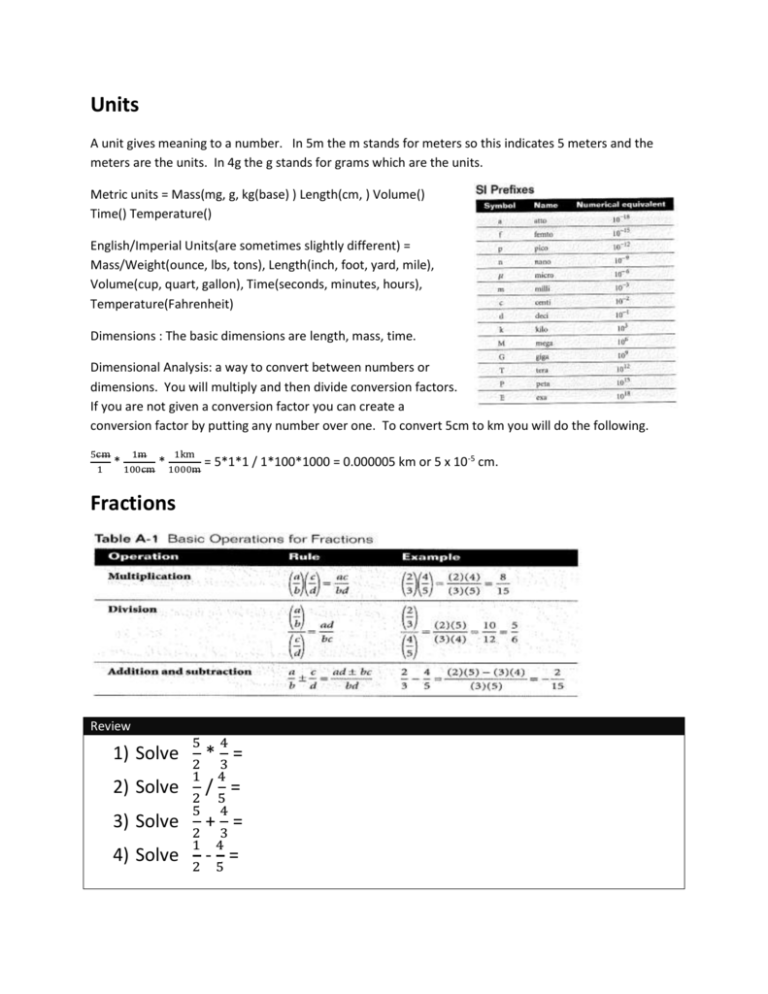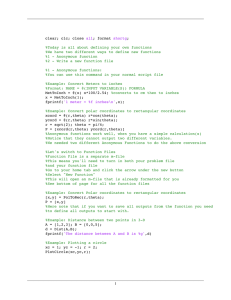Physics Review Math
advertisement

Units A unit gives meaning to a number. In 5m the m stands for meters so this indicates 5 meters and the meters are the units. In 4g the g stands for grams which are the units. Metric units = Mass(mg, g, kg(base) ) Length(cm, ) Volume() Time() Temperature() English/Imperial Units(are sometimes slightly different) = Mass/Weight(ounce, lbs, tons), Length(inch, foot, yard, mile), Volume(cup, quart, gallon), Time(seconds, minutes, hours), Temperature(Fahrenheit) Dimensions : The basic dimensions are length, mass, time. Dimensional Analysis: a way to convert between numbers or dimensions. You will multiply and then divide conversion factors. If you are not given a conversion factor you can create a conversion factor by putting any number over one. To convert 5cm to km you will do the following. 5cm 1m 1km * * = 1 100cm 1000m 5*1*1 / 1*100*1000 = 0.000005 km or 5 x 10-5 cm. Fractions Review 1) Solve 2) Solve 3) Solve 4) Solve 5 2 1 2 5 2 1 2 4 * = 3 4 / = 5 4 + = 3 4 - = 5 Converting between fractions and decimals Review 1) Convert to decimal 4% 4 2) Convert to decimal 3 5 3) Convert to percent 3 4) Convert to percent 0.34 Exponents Review 1) 2) 3) 4) 5) Solve: x0 * x3 = Solve: x-4 * x5 = Solve if x=4: x1/2 = Solve if x=2: x3-x2 = Solve: x2/x4= Algebra Solving Unknowns Multiplication, division, addition and subtraction are operations. A variable is a symbol (usually x,y, or z) that can be solved for. You usually cannot solve for more than one variable at a time. To solve for x in 7=x+5. Step 1 – Rewrite the problem Step 2 – Rearrange to isolate the variable(Isolate the variable by moving items across the equals sign. Change the operation when you go across the equals sign. Combine like terms(x+2x=3x)) Step 3 – Solve the problem Addition/subtraction 7=x+5 7-(5)=x+5(-5) Multiplication/division 45=5x 2=x or x=2 x=9 45 5 = 5 5 x Review 1) 2) 3) 4) 5) Solve for x: Solve for x: Solve for x: Solve for x: Solve for x: x+5=4 x - 4 = 16 5x + 5 = 4 3x = 4 + x 4x = 4 Geometric Formulas Review 1) 2) 3) 4) 5) Find the area of a cylinder with radius of 3. Find the area of a cube with the side of 14. Find the area and circumference of a circle with a radius of 11. Find the area of a triangle with a height of 4 and a base of 12. Find the area of a square with a length of 4. Linear Equations Review 1) Solve for x and y a) 3x+y= - 6 and -4x -2y = 6 b) x – y = 2 and x - 2y = -1 Trig Functions Review 1) 2) 3) 4) 5) Refer to the above drawing Solve for c if theta=45 degrees and a = 4 Solve for c if theta=45 degrees and b = 3 Solve for a if c=12 and theta=30 degrees Solve for a if theta = 65 degrees and b = 2 Solve for c if theta = 20 and a = 14 Pythagorean Theorem Review 1) 2) 3) 4) Refer to the above drawing Solve for c if b=12 and a=5 Solve for c if b=3 and a=2 Solve for a if c=12 and b=5 Solve for b if c=45 and a=12 Graphing (3,4) is an ordered pair where x=3 and y=4 in Slope of a line y=mx + b (m=slope, y =independent variable, x=dependent variable, b=y intercept ) m = dy/dx Direct Relationship: When the line created follows a increasing slope. A) Inverse Relationship: When the line decreases with the independent variable.b) Exponential Relationship: When the line increase exponentially. Review 1) Find the slope for the two coordinates (4,3) and (2,2) 2) Create an exponential, inverse and direct graph. Graphing. Retrieved August 28, 2012, from http://www.glynn.k12.ga.us/~pmcveigh/COURSES/PHYSICS/NOTES/graphing.html Serway, R. A., Faughn, J. S., & Holt, R. Holt physics. Austin, Tex.: Holt, Rinehart and Winston, c1999 Trig metric Functions. Retrieved August 28, 2012, from http://studymath.us/tag/algebra











